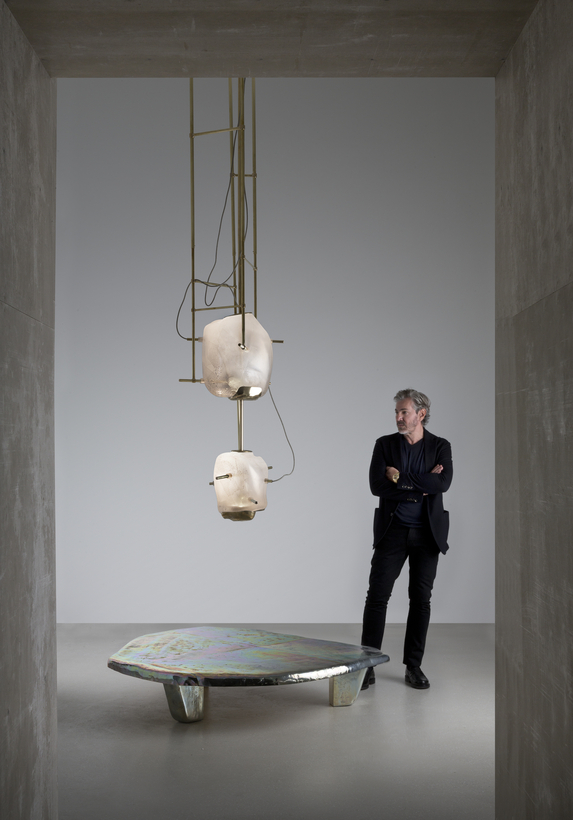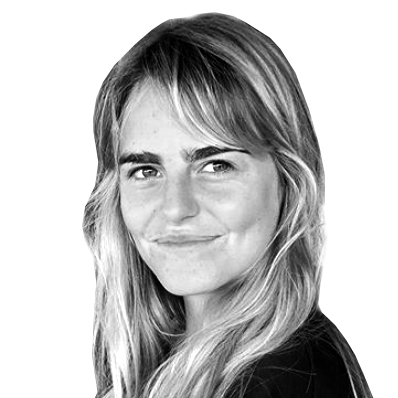Vincenzo de Cotiis does not shy away from abstraction. The objects he designs are gestural—both brutal and elegant, organically raw and technically refined, futuristic yet informed by Italy’s rich history. Their austerity points to 1970s industrial design, when Carlo Scarpa and Gio Ponti revolutionized the field with their less-is-more approach. But de Cotiis doesn’t let functionality stand in the way of aesthetics. His pieces balance on the invisible beam between architecture and art.
Today de Cotiis, 62, lives and works in Milan, and his sculptural tables, cabinets, and chairs—which can sometimes suggest ancient torture devices—populate residences throughout Europe, from Ibiza to Paris, Saint-Moritz to Cyprus. Not a man of small measures, de Cotiis lives in a 17th-century Milanese palazzo—a 3,300-foot apartment just off Corso Magenta—where excavated walls and pink frescoes are juxtaposed with custom furniture in black, gray, and silver. The inherent tension between the archaic setting and the totemic décor is bracing, fresh, a de Cotiis signature.

Opposed to mass production and commercial work on principal, de Cotiis’s area of focus is slowly shifting away from houses and edging into fine art. He is now represented by the prestigious Carpenters Workshop Gallery, where his New York exhibition, titled “Éternel,” opens May 10. The pieces in the exhibition were inspired by de Cotiis’s recent trips to Japan and his fascination with the country’s richness of forms and shapes. Look for references to bonsai gardens, cherry blossoms, landscapes, lanterns, dragons, and Temples, but in the mediums of iridescent glass and metals mixed with stone. On the eve of his exhibition, we caught up with the artist.
ELENA CLAVARINO: Why did you move from Venice to Milan?
VINCENZO DE COTIIS: I studied in Venice and later in Milan, where I have lived now for a long time. The city has certainly influenced the way I see the world through art. It’s a place full of contradictions and culture. You have to really search and seek out the best places, and for this reason it’s a very inspiring and energetic city.
E.C.: When did you know you wanted to go into architecture and design?
V.C.: I have always been drawn towards art. As a child, I had a strict upbringing from a military father. He wanted me to get a solid education and that is why I studied architecture, but my heart has always moved towards art.
E.C.: How do you think being Italian has influenced your work?
V.C.: I think that every Italian is inspired by our cultural heritage. Whether you like it or not, growing up in this country, you’re surrounded by old beauty. Unique architecture and important works of art have an effect on your aesthetics. We could probably look for the origins of Italian design in the Renaissance, when educated people were experimenting in their ateliers. Italian design went through endless transformation, from industrial design and mass production—with a focus on the ergonomic popularized in the 1950s—to Contro Design and other more artistic and experimental trials in the 70s and 80s. That’s the time that is closest to my heart. You can often feel the connection between the past and the future in the consideration for every detail, evident in Italy’s great history of craftsmanship. Italian design is influenced by Italian culture and art. I believe I am a deeply classical man, in a broader interpretation of the term. Belonging to a certain Italian spirit is, I believe, evident in everything I create.

E.C.: Some of your work reminds me a bit of Gio Ponti or Carlo Scarpa. What have you learned from them, and from recent Italian design history?
V.C.: The Italian architect Carlo Scarpa and the American artists Donald Judd and Frank Stella are among those who have influenced me. But I’ve taken a much more artistic path than Scarpa or Gio Ponti. With each material, I like to give a new life, like in Arte Povera. The rough art forms of Arte Povera and Brutalist architecture belong to my DNA. When I started, I wasn’t influenced by the Memphis group but by avant-garde Japanese architecture. I am passionate about all artistic forms. I make no distinction. And I believe that the three areas—architecture, interior design, and art—are animated by the same energies.
E.C.: How would you describe your style?
V.C.: I would rather speak about language than style. I think I can say that my language is changeable, in constant movement and adaptation. It is constantly fed and imbued with innumerable stimuli that come from many different sources: art, literature, landscape, and relationships, to name just a few. Then, there are the constant elements that can be identified or recognized over the years. Affection for salvaging materials and for the matter itself, the attempt to bring together apparently distant and very different materials, formal research that often draws from the natural world, the experimentation with techniques not always belonging to the world of art.

E.C.: What’s your working process?
V.C.: Even if the starting point is often a sketch, it is the matter itself which shows me how to move, and often the objects change shape during the manufacturing process. Abstraction, undoing the functional aspects of objects and things is a process that fascinates me. It is perhaps natural to have now come to this so decisively, and perhaps I will move evermore in that direction.
E.C.: What’s the most important work you’ve ever completed?
V.C.: The next one.
E.C.: What does “perfect imperfection” mean to you?
V.C.: Recently I have heard this term more and more often, which means it’s probably becoming a trend for many. When I started, it had a different meaning for me. Combining different materials, and smooth surfaces with rough surfaces, is something I love doing because they have different tensions, structures, and materiality. Recycled fiberglass has been important in my work since I started using it 30 years ago. What’s constant in my research is that there’s always the passage of time underneath these materials. I’ve always been more attracted to a lined face—a “perfect imperfection”—than a completely unlined one. Thinking about how time has passed through materials informs my initial design idea.
E.C.: Tell us about the “Éternel” exhibition.
C.V.: “Éternel” was born from emotions that I’ve felt during my frequent trips to Japan, and my memories of lanterns and minimal forms of architecture that I’ve sought to transcribe in contemporary works. I wanted to convey the iridescent landscape of Japanese cherry blossoms, how the color moves from blue to pink and green. Reflections are another important element, as I saw many reflections, not just in the landscape, but in the cities where one has constant reflections from technology. And I tried to represent Japanese ceramics by manually coloring recycled fiberglass with those nuances and depicting it like Japanese painting. I’m very happy with this body of work, because it represents a new step in my work and how I’ve resolved to release myself from tradition.
E.C.: What piece of advice would you give an aspiring designer?
V.C.: Find your own way.
Elena Clavarino is an Assistant Editor for Air Mail

